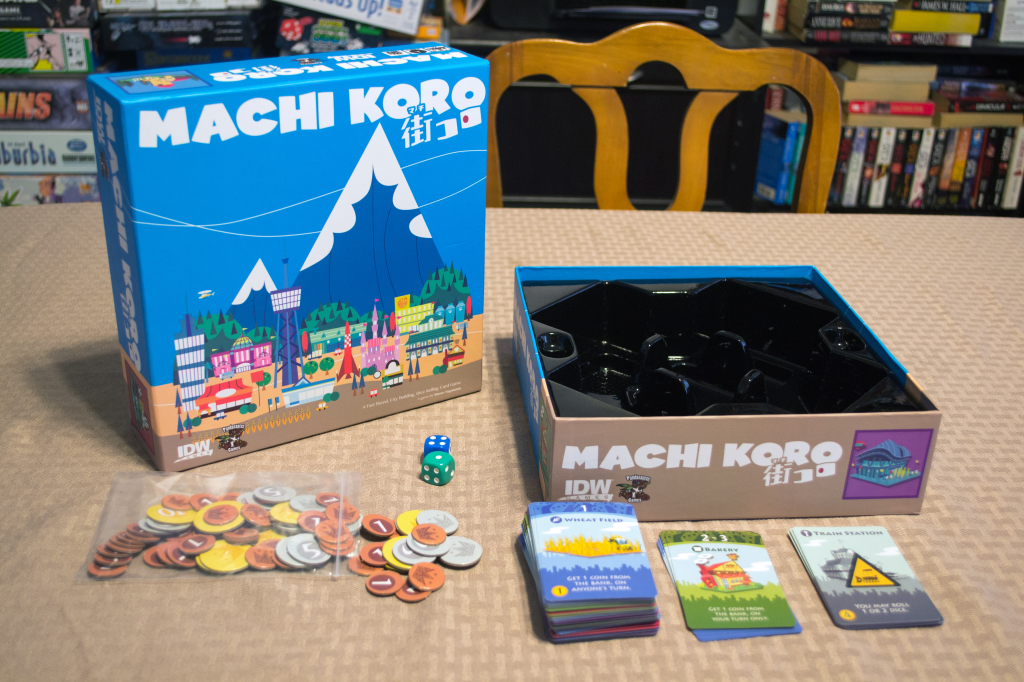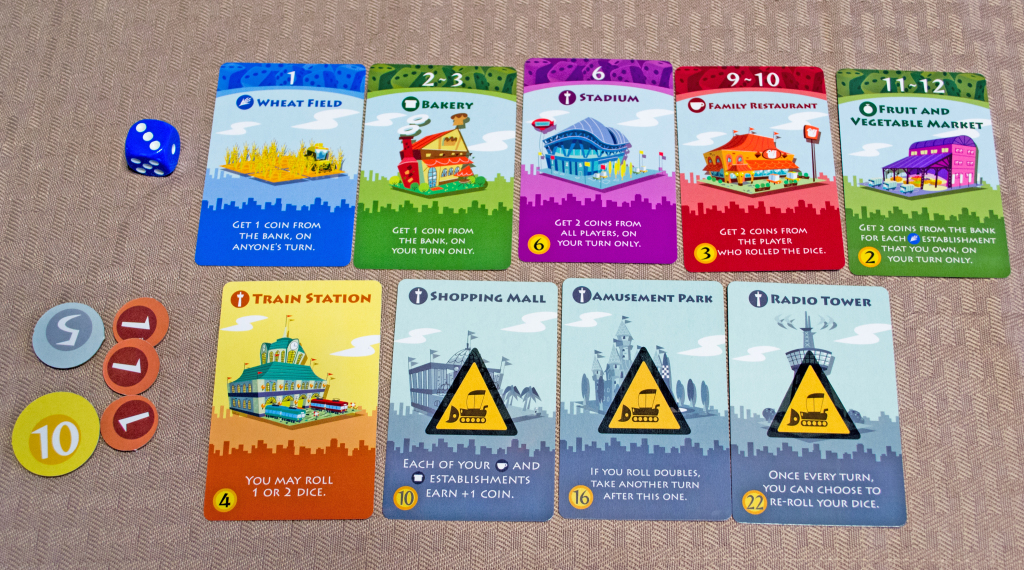“Machi Koro” strokes my ego like any other city builder in that it lets me be the mayor of my own city. Luckily, this one isn’t the type that takes hours to play. Competing against other players/mayors, your task will be to develop all of the landmarks in your city before your opponents can do the same in their own cities. In addition to building landmarks, players will be able to purchase establishments that give them the funds they’ll need to expand their city and win the game. The question remains, did I enjoy it as much as “Sunrise City” and “Suburbia”?
Components
Cards – There are two card types: establishments and landmarks. Landmarks are needed to win the game while establishments will assist players in generating revenue and performing other helpful actions.
Coins & Dice – Coins come in 1, 5, or 10 denominations and there are two six-sided dice.
Setup & Gameplay
Each player will receive two starter establishment cards (wheat field and bakery), a set of four landmark cards (station, shopping mall, amusement park, and radio tower), and three coins. The landmarks are placed gray-side up showing that they haven’t been constructed yet. The rest of the establishments are separated by type and placed into their own supply piles. The large pile of unused coins will form a bank and is placed off to the side along with the dice. A first player is chosen at random.
On a player’s turn, they’ll observe the following actions:
1) Roll Dice – The active player will roll one die. If the player has the “station” landmark built, then they may choose to roll either one or two dice.
2) Earn Income – ANY player with an establishment that matches the value rolled will earn the benefit listed on the card, which usually involves earning income from either the bank or other players. It’s important to note that some card effects can only be carried out on your turn, so you’ll need to observe the color of the card. Blue cards allow you to earn income from the bank on anyone’s turn, green cards allow you to earn income from the bank but only on your turn, red cards allow you to take money from the player who rolled, and purple cards allow you take money from ALL other players but only on your turn.
Note: When earning income and paying other players happens at the same time, payment is resolved first. Payment to other players is resolved in counter-clockwise order. Should a player not have enough money, then they’ll pay what they can and ignore the rest.
3) Build – The active player may either build one establishment or one landmark, paying the bank with coins appropriately. Building a landmark will allow you to flip it to its active side and gain its benefits.
The turn ends and play proceeds clockwise. The first player to construct all four of their landmarks wins the game!
Editor’s Note: The above doesn’t cover all of the rules found in the manual, but should give you an idea as to how the game is played.
The Review
“Machi Koro”, if I had to compare it to other games I’ve played, is like a cross between “The Settlers of Catan” and “Dominion”. It’s like “Settlers” in the sense that players can earn income via a die roll even when it’s someone else’s turn. The cards themselves and the roles they play are equally reminiscent of “Dominion”. Landmarks, for example, are your “victory” cards while establishments act like “action” cards. Granted, you’re not building a deck and only drawing some cards for use on your next turn, but you’re still growing your arsenal throughout the game in order to give yourself more options.
From a learning curve standpoint, “Machi Koro” is MUCH easier to learn and play than “Suburbia” and “Sunrise City”. As such, I’d consider it a good entry-level city builder game to introduce to casual gamers and younger kids. It’s simple enough to serve as a nice filler in between longer play sessions, though I’m fine with it being the main attraction on game night. There aren’t that many components, making it all very easy to set up and clean up. Some folks may not care about such things, but busy families like mine will understand how difficult it can be to just sit down and breathe from time to time.
In terms of balance and strategy, it all comes down to how many people are playing the game. Purple cards have the benefit of earning income from every other player, for example, but that won’t do you a lot of good in a two player game. Seeing as how expensive purple cards are, I could only recommend them in a three or four player game. Dice rolls will add a luck factor no matter which game you play, though you can play the odds a bit by buying cards across the range of numbers to ensure you get a hit on a regular basis. Then again, investing on cards featuring just one or two of the same number will allow you to rake in the dough all at once assuming you’re lucky enough to get a hit.
In the end, I found “Machi Koro” to be an elegant little game that combines just the right amount of strategy and casual fun for busy gamer families like myself.
Final Verdict: 8/10
—


